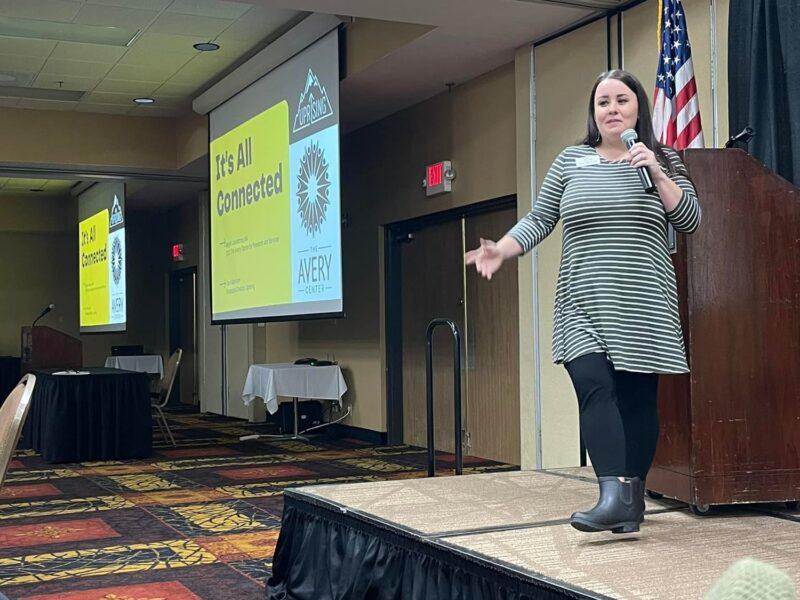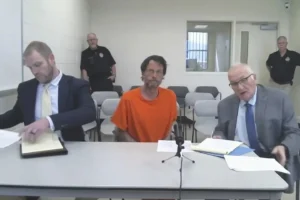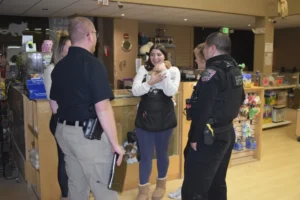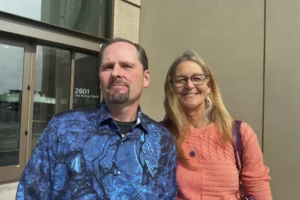Number of Sex Trafficking Arrests in Wyoming Doesn’t Tell the Whole Story
Largely unreported problem as trafficking is misidentified or missed; state invests in training law enforcement to recognize signs
- Published In: Criminal Justice
- Last Updated: Oct 17, 2022

Terri Markham of Uprising speaks at the Greater Rockies Immersive Training on Exploitation and Trafficking (GRIT) conference in May in Sheridan. This was the first human trafficking conference held in Wyoming. (Courtesy photo from Uprising)
By Jennifer Kocher
Special to the Wyoming Truth
A recent survey suggested that human trafficking is on the decline nationally, but experts warn that it is a largely unreported crime in Wyoming and beyond.
The Human Trafficking Institute’s (HTI) 2021 Federal Human Trafficking Report, which tracks annual cases of sex and forced labor trafficking filed in federal court systems throughout the country, counted 140 new criminal human trafficking cases in 2021. These cases accounted for 449 victims with 92% involving sex trafficking and 8% involving forced labor; over half of the sex trafficking cases involved minors.
Trafficking cases were reported in 52 of the 94 federal court districts, which is down about 15% from last year. Likewise, arrests were also down by 22% nationally.
Only one case was reported in federal court in Wyoming, compared to zero in 2020, while neighboring South Dakota had 59 new sex and labor trafficking cases. Five were reported in Montana, 13 in Nebraska and five in Colorado. California had the highest number of reported cases at 212.
There likely are many more unreported cases in Wyoming, according to Cara Chambers, Director of the Division of Victim Services for the Wyoming Attorney General’s Office and chair of the Missing and Murdered Indigenous Persons Task Force.
Part of the problem is that the state human trafficking statutes enacted in 2013 are intended to prosecute the traffickers, not the buyers or the victims, she said.
“In other words, the state statutes are designed to go after the bigger fish,” Chambers said.
A second key barrier is recognizing the difference between willful prostitution and trafficking. Trafficking is often misdiagnosed as prostitution, a financial transaction between two consenting adults, which is considered a misdemeanor in Wyoming.
Recognizing differences
Chambers said the state is focused on training law enforcement and other first responders to understand the difference, rather than go after the buyers and sex workers, who, in most cases, are actually victims, statistics show.

To this end, Chambers’ division has partnered with groups like Uprising, a Sheridan-based nonprofit that delivers human trafficking prevention education and trainings to law enforcement and community groups. Uprising Executive Director Terri Markham has conducted eight trainings in the past two years and subsequent sex-trafficking stings, such as the one last month in Gillette.
The state funds Markham’s group to bring in experts like Joe Scaramucci, a detective with the McLennan County Sheriff’s Office in Texas. Scaramucci is a renowned expert on human trafficking and has trained hundreds of local, state and federal law enforcement agencies nationwide.
In his trainings, Scaramucci makes clear the difference between prostitution and trafficking: in trafficking, victims are being exploited to perform sex acts against their will, often through coercion, drug addictions, threats to the victims themselves or their families and other tactics.
For this reason, victims are afraid to turn in their traffickers and expose these criminal enterprises, according to Scaramucci. Instead, they take the fall for the offense, whether it be for misdemeanor prostitution or drug charges.
Underreported problem
Typically, victims hail from other states and are being sent by their traffickers on circuits in Wyoming along the I-90 and I-25 corridors, Chambers said. These circuits can originate from traffickers in major western cities such as Denver or Salt Lake City, and anecdotally Chambers has heard that Las Vegas is a popular hub for traffickers. The circuits tend to follow large events and gatherings, such as professional sporting events, concerts and annual festivals like Cheyenne Frontier Days.
When arrests are made, the traffickers might be charged in another state or federally. This data is harder to capture, she said, and doesn’t represent the true nature of the problem in Wyoming.
“We just see low numbers in this state because it’s underreported,” she said.
Statistics gathered by the National Human Trafficking Hotline seem to underscore that problem. Based on their data, there have been 395 contacts, including phone calls, texts, online chats and submitted forms, in Wyoming since 2007. In 2020, 47 people in Wyoming contacted the hotline with 11 human trafficking cases reported.
More often than not, Chambers’ office helps the victims return home, where more resources are available, and works with state agencies affiliated with the National Compendium of State-Run Anti-Trafficking Initiatives to provide compensation and other services.
A big push for Markham’s trainings is to encourage law enforcement and victim services agencies to work together to recognize trafficking and assist victims.
Punishing the victim
One effective example of this partnership is in Crook County, where Director of Crook County Family Violence and Sexual Assault Services Sandy Stevens works in tandem with the sheriff’s office and Wyoming Highway Patrol. It helps that Stevens is married to Eric Stevens, patrol sergeant with the Crook County Sheriff, she said.
“It’s hard for him to ignore it because I’m constantly pushing,” she said with a laugh.
In the past year, Stevens’ agency responded to three potential human trafficking incidents. In one case, a highway patrolman, who had just attended an Uprising training, noticed a female motorist parked on the side of I-90 early in the morning. He approached the vehicle to see if she needed assistance.
Right away, the officer noted the woman’s risqué clothing and her evasiveness when answering questions, Stevens said. She told him she’d pulled over to upload money on an app for her boyfriend. The patrolman recognized those signs of sex trafficking. But because the woman also had drugs in the car, she was arrested and taken to jail.
The other two cases were similar. In all three, no human trafficking charges were brought because none of the women turned on her abuser. Instead, they took the fall.
“It’s hard,” Stevens said. “But even though she’s a victim, she broke the law.”
It’s common for traffickers to use drugs and addiction to coerce their victims, Stevens said, but at least being in jail for a short period ensures their safety while allowing them to sober up and get access to resources. Once on probation, victims have greater accountability to stay out of trouble. In some cases, she said, victims receive travel money to return home or counseling to help them leave their abusers.
Rampant use of social media for trafficking
One of the biggest misnomers is that human trafficking involves defenseless women and children who are snatched out of parking lots by nefarious people in vans with tinted windows, Scaramucci said.
Typically, sex trafficking victims are groomed by men who shower them with love and pretend to be in a relationship with them – also known as a “Romeo pimp.” Once they have gained the victims’ trust, they force them into the sex trade.
As Scaramucci demonstrates in his trainings, there’s also no shortage of buyers and sellers on social media. On popular adult websites, escort and sex services are blatantly offered for “roses” or “donations” as opposed to cash.
Until the demand stops, Scaramucci noted, sex trafficking will continue. And demand shows no sign of slowing. After placing his sex ad on a popular site in Gillette before the September sting operation, Scaramucci received 79 responses in two days, beginning early in the morning right after the ad was posted.
“It’s a business,” he said, “plain and simple.”













